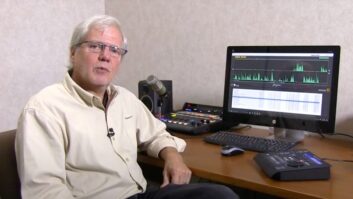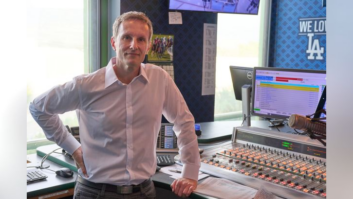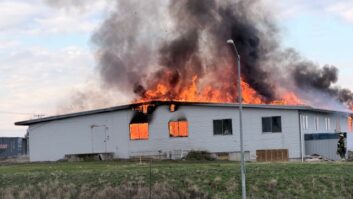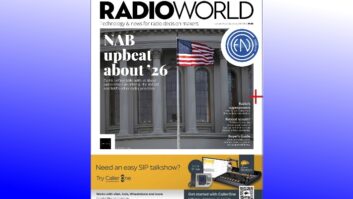WGBH Radio Boston is going boldly where no public radio station has gone before, by opening a “virtual studio” on the Second Life Web site.
Established in 2003, Second Life is a user-created 3D virtual world. Similar in style to the popular “Sims” computer games, Second Life offers “residents,” its users, the chance to recreate themselves as avatars or 3D customizable beings, then buy virtual properties to construct buildings and engage in whatever virtual lifestyle appeals to them.
(click thumbnail)Gary Mott in the control room for the Fraser Performance Studio.“Using a grant from the Corporation for Public Broadcasting’s Public Media Innovation Fund Program, we are going to construct a virtual music studio based on the actual Fraser Performance Studio,” said WGBH radio producer Gary Mott.
“It will have an auditorium space where Second Life avatars can go to hear live concerts modeled on those we broadcast on WGBH 89.7. Our goal is to see how Second Lifers react to this opportunity: Will they attend concerts? Will we reach people who do not usually listen to public radio? We will only find out by doing it.”
Its world
Take a quick look around Second Life and you will see that this is not just another computer game. In fact, it is a place where users can create their own “second lives,” trying personas and lifestyles that, for one reason or another, they can’t attain in reality.
In this alternative world, each avatar can move about, interact with objects and other avatars, and generally conduct itself as if it were living here. This is where the genius of WGBH’s experiment comes into play: By purchasing “land” in Second Life and building a concert hall, the station is creating a destination for Second Life gamers.
According to site statistics, there were 12.2 million “residents” or unique avatars in use at Second Life at the end of January.
Intriguingly, land is not free in Second Life. You have to pay for it using Linden dollars, which have a 270:1 exchange rate with real U.S. dollars. Linden dollars are purchased through the Second Life site.
To purchase the 16 acre private island needed for its virtual studio, WGBH will have to pay $1,675 to the site, plus an additional $295 to maintain the “land.” Apparently, even unreal estate has real value in today’s market.
Beyond the DialWGBH is one of several public broadcast entities to receive funding for new media initiatives from the Corporation for Public Broadcasting. CPB’s Public Media Innovation Fund Program encourages experiments with emerging platforms. Grants are for up to $20,000. Results will be shared with the public broadcasting system.
Other recipients:

- KET/The Kentucky Network — “Connectivity, Choice and Participation” will test Web 2.0 strategies to increase secondary school student proficiency and engagement in the study of German.
- Oregon Public Broadcasting — “Invasive Species Online Hotline” will employ user-generated content and social networking tools to connect the public with invasive species experts to help stop the spread of invasive plants and animals in Oregon.
- WFUV/New York — “WFUV Online Local Music Network” will create an online social network for musicians and music lovers to access independent, emerging music.
- Penn State Public Broadcasting — “Back from Iraq: The Veterans’ Stories Project” will use a course-based model and Web 2.0 strategies to empower and train Iraq veterans to complete in-depth audio and text portraits of fellow Iraq veterans.
- Northwest Public Broadcasting — “Our Northwest News” 2008 will test the use of online game-playing, blogs, wikis and other strategies to engage the audience with regional news stories in Washington state.
Considerations
“The building we have planned will look like the Fraser Performance Studio on the outside, with the letters ‘WGBH’ branded on it,” said Mott.
“Avatars will get to it by teleporting, the preferred form of transportation in Second Life. They can go inside and sit down for the performance, which will be in real-time at a virtual Steinway.”
“We haven’t decided whether we will be using avatars on stage that resemble the actual performers. There is also the issue of coordination; do we try and make the avatar’s hands move in time with the music, or disguise what they are doing by placing the piano at a different angle? And do we do our Second Life performance at the same time as our on-air live broadcast, or after the fact?
“These are all points that need to be worked out.”
Ironically, the degree of realism afforded by Second life could pose problems for WGBH.
In this virtual world, there is nothing to stop the avatars from talking to each other during the performance, or getting up and interfering with the performer. Such is the versatility of this world, in fact, that the station may need to define certain limits into its program, to keep the avatar audience away from the stage; sort of cyber-security, if you will.
It’s not hard to see why WGBH, or indeed any radio station, would want to get a stake in Second Life. Foremost, it’s part of a medium that is drawing people away from time spent with radio and TV. To keep up with them, it makes sense to follow them.
Second, Second Life represents a chance for WGBH to promote its traditional services to non-listeners. If they like what they hear in Second Life, perhaps they’ll tune to the real radio station at home, in their cars or on the Web.
This said, WGBH is heading into its Second Life experiment with its options open.
“We simply want to get into Second Life, to see what happens for us there and how people react to it,” Mott said. “Basically, we’re going in as virtual anthropologists, to find out what we can learn about this Brave New World. Besides, live music has a proven cachet for Second Lifers,” he added. “WGBH-89.7 broadcasts more than 100 live events annually. This is something we already do, that could bring us new devotees from a different space.”







